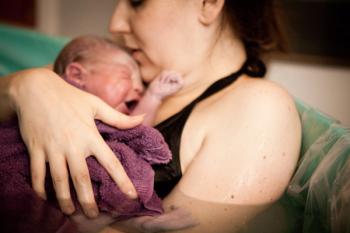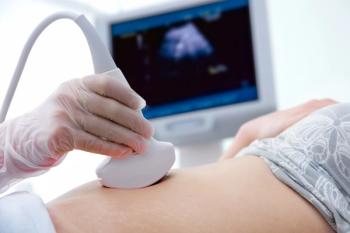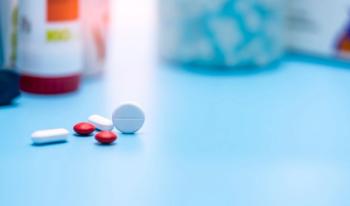
The Constant Change of Ultrasound
OBGYN.net Conference CoverageFrom 45th Annual Conference of the AIUM - Orlando, FL 2001
Dr. Eric Blackwell: "I'm Eric Blackwell, and I'm the Co-Editor of the History of Ultrasound project for OBGYN.net and the Society of Diagnostic Medical Sonographers. We're here at the 45th Annual Convention of the AIUM in Orlando this year, and I have just attended a 'Meet the Professor' session with Dr. Barbara Carroll from Duke who has been kind enough to agree to talk with us a little bit. Dr. Carroll, I know you've been involved in ultrasound almost since it was first even thought of as a medical tool and maybe even before, and I'd love to know how did you first get interested and who were some of the people that might have been your teachers or mentors?"
Dr. Barbara Carroll: "It's very interesting, the first person who really made me aware of how potentially useful ultrasound could be was Roy Filly. Roy was a third year resident in radiology at Stanford when I was first year resident in radiology, and Roy always used to tell me I should really look into it. At that time, we weren't even using any clinical ultrasound except A-mode for neuro and so I thought that was really fascinating. Roy then left and I continued on in my radiology residency, we didn't have anybody doing ultrasound or anything like that but towards the third year of my radiology residency they decided they should really have some ultrasound. Also, some of our biomedical engineers at Stanford were actually devising prototype ultrasound machines and stuff so we started looking into it. By the beginning of my third year in radiology residency I was part of a national science foundation program where you took a year off and did research as part of your residency and that was funded. For my research year, since Jason Burn-holts had just come on board as a faculty person to do ultrasound, I thought I'd do ultrasound since Roy had said what a great potential that had. But Jason was just getting started and so I thought I'll do some neuro CT because that was also just getting started so I did a part neuro CT and part ultrasound fellowship basically in that third year of residency."
Dr. Eric Blackwell: "So you're probably one of the few that actually saw a midline echo encephalography give way to computed tomography in the emergency center."
Dr. Barbara Carroll: "Absolutely, and no more pneumoencephalograms, oh, what a wonderful thing that was when that went away."
Dr. Eric Blackwell: "That's right, that was a bit barbaric."
Dr. Barbara Carroll: "Yes, and so that was very exciting and I actually wrote a paper in neuro CT but then I got into ultrasound, and ultrasound was so different then, we're talking about 1974-1975. I think the first machine we had was an old Siemens, at any rate it was one of these machines that had a phosphorescent screen and it had green dots on it. You made pictures by painting back and forth with your transducer until you got the density of green dots that you wanted, and then you took a bezel-type camera and put it on there and clicked a Polaroid picture."
Dr. Eric Blackwell: "I even remember some artistic techniques where you would try to make a swoop to get as many angles, do you remember?"
Dr. Barbara Carroll: "Right."
Dr. Eric Blackwell: "So you actually saw the swoops on the edge of the pictures like a CT scan though it really gave you sort of a global."
Dr. Barbara Carroll: "You could make that attempt, of course, the bones, the gas, and everything didn't cooperate. So we did that for a while and then the next thing I knew the engineers brought over some prototype machines. They had these real-time machines that were wobblers, and they were like massage machines. Then the next thing I know Searle actually came out with a very lovely static grey scale imager, the first really ultrasound machine that was not a prototype that we used. We also were lucky enough at the very beginning to share the Varian sector scanner with the cardiologists so we actually got some experience using one of the very first real-time sector scanners."
Dr. Eric Blackwell: "Now hadn't that come out of Fritz Thurstone's development lab?"
Dr. Barbara Carroll: "No, no, that was actually a different machine. I think they called that one the soma scan or something like that but Fritz actually did develop the first sector array machine but it was not commercially available as soon as the Varian prototype was."
Dr. Eric Blackwell: "I actually visited that lab at Duke, I guess Steve Smith was one of his graduate students at the time, and we saw these marvelous pictures. What you didn't see was the cable disappeared through the wall and there was a PDP-11 computer."
Dr. Barbara Carroll: "With two air conditioners."
Dr. Eric Blackwell: "Exactly, so it was amazing how quickly things then filtered down to workable machines."
Dr. Barbara Carroll: "It's truly fascinating because later on their machine was actually one of the first digital machines as well. At any rate, we had those machines and those were our standards that we used all the time. Those were actually very good, and still to this day some of the resolution that you see with those static scanners is just about as good."
Dr. Eric Blackwell: "I have thyroid pictures when Picker came out with the little very high frequency one."
Dr. Barbara Carroll: "That little 10-megahertz Picker - that was beautiful."
Dr. Eric Blackwell: "It was not bad."
Dr. Barbara Carroll: "Not bad at all, then we were very fortunate because in our area, Silicon Valley started to become a hotbed of ultrasound activity. Sam Maslick and Acuson came along and people just began to pore into that, and it was very exciting because Diasonics was in the area and they were coming out with some beautiful machines and some of the first Doppler machines to come out. ATL, of course, was also coming out with Doppler machines and it was an exciting time because new machines were coming around to be tried out. We actually worked closely with some of the Silicon Valley companies to help develop some of their first machines so it made it pretty exciting. With each change you always wonder what's going to happen next, and how can anything be better than this. You work with an open shutter persistence scope and now you've got all sorts of these beautiful real-time grey scale machines that are making beautiful pictures."
Dr. Eric Blackwell: "Exactly, I remember the transition to actual television display. We had a unit that used the Hughes scan convertor which lets you get a TV picture but it had to warm up for about forty-five minutes each day before it stabilized, and then it had to be constantly tweaked."
Dr. Barbara Carroll: "They did a very impractical emergency machine."
Dr. Eric Blackwell: "One of my favorite early day stories is our service engineer for Picker serviced a number of other small communities around the Texas and New Mexico area, and he came in laughing one day. He had just come from an installation where all the controls were covered with tape because they'd finally gotten a good image and they weren't going to touch it."
Dr. Barbara Carroll: "Don't change anything! Don't change anything! Actually my very first machine was a Picker. I was trying to remember what it was, but it was actually a Picker."
Dr. Eric Blackwell: "Instead of the Searle."
Dr. Barbara Carroll: "No, the Searle was the first static grey scale machine that we actually used clinically but the one I was telling you about with painting with the fluorescent, that was a Picker."
Dr. Eric Blackwell: "Right, and then there was the Roll-lie which could trap you. Do you remember that one? That had the automated thing that went around the end of the bed to switch from sagittal to transverse, and if your leg happened to be in there, it would take it right off."
Dr. Barbara Carroll: "I do remember a machine that was over at the VA that was an experimental machine that looked like it was a wine barrel. It was lined inside with transducers and you got down into the middle of the wine barrel and it took pictures sort of like the Octoson."
Dr. Eric Blackwell: "At least that one had a membrane and you could lie on top of it."
Dr. Barbara Carroll: "This one was just a barrel that you got into."
Dr. Eric Blackwell: "I've seen the pictures from Howry and the other people who were at Colorado in the early days where they actually had a gun turret that they filled with water and they had the transducer that went around making compound motions but you had to sit in it holding sandbags to keep you from floating up."
Dr. Barbara Carroll: "To keep you from rising."
Dr. Eric Blackwell: "And early sanitation questions about patient to patient. I wonder who some of the other people were from the earliest days you can remember? Did you ever cross paths with Fred Sample, for example?"
Dr. Barbara Carroll: "Actually, Fred Sample and I were colleagues and we even co-authored a paper together. He was just a wonderful and delightful person. In fact, in those days those of us who did ultrasound were sort of outcasts from the rest of the imaging community to a certain extent - everybody laughed at the pictures - so people who were really believers became very close as a rule because we were all learning so much new things at the same time and anything you could learn from somebody else was immediately applicable here."
Dr. Eric Blackwell: "I remember Fred only as a teacher who finally helped me understand some of the cross-sectional anatomy and was so enthusiastic about things."
Dr. Barbara Carroll: "Roy, of course, returned to UCSF while I was still at Stanford and so it was very nice to interact with him. Of course, George Leopold was a major mentor, in fact, one of the nicest things that happened had to do with the LA Radiologic Society because very early on they started putting on a spring ultrasound meeting which became a major meeting across the country. They always liked to invite the local people because I'm sure it didn't cost nearly as much to get them to come down. We would have a wonderful session which is subsequently largely gone away I think because since I moved to the east coast, I don't go as frequently. But they used to have a Thursday night session where there were workshops and everybody presented the same cases. Everybody was suppose to get their bottom line together on Thursday nights so they were all going to be conveying the same messages to the attendants because they all showed the same cases but they were all in different workshops that were going on. Barbara Gross-ink would be in one room and I'd be in another room, we'd be giving the same slides and showing these things but we wanted to make sure we agreed about what we were going to say related to the slides. Those would be great sessions. People would argue with each other and stand up and say, 'oh, that's bologna' and 'that's not right' or 'we do it differently at our place' or 'I've never heard of such a silly thing.'"
Dr. Eric Blackwell: "Hammering out the basics."
Dr. Barbara Carroll: "It was very instructive since there was nobody there and since everybody was pretty much collegial, you could basically pretty much say what you wanted to and you learned a lot because people were not afraid to tell you what they thought in that sort of closed environment. Like I said, people were pretty much friends anyway so it was a really good session but that's where in this cohesive group of people that really sort of began to give ultrasound a push would get together and learn from each other. Those were really always very enjoyable sessions."
Dr. Eric Blackwell: "I still laugh about a slide that Dr. Barry Goldberg put up at a meeting way back in the early days when, as you said, people wondered what those of us who were interested were thinking because could this possibly be any good, and he had a slide that showed his vision for ultrasound. It showed a marble staircase leading up and it had ultrasound over the top and there was a little sign that said Radiology in the basement. I think Barry if anybody may have actually come close to bringing that one off."
Dr. Barbara Carroll: "Come closer to doing that, yes."
Dr. Eric Blackwell: "Now I do know you made a transition from the west coast to the east coast or maybe you did things in between but I know you were at Stanford and now you're at Duke and you've been at Duke for some time. Was there an intervening position there?"
Dr. Barbara Carroll: "No, I just went from Stanford to Duke pretty much. I was delighted to have the opportunity to come to Duke, I love Stanford but my husband-to-be was you know."
Dr. Eric Blackwell: "For those who might not know this, it's Dr. Olaf von Ramm. Did I get the pronunciation right?"
Dr. Barbara Carroll: "That's correct, actually I had scheduled to go to a sabbatical at Duke but at the end of that time we decided that it would be easier for me to stay on. It's been a real pleasure being there because working with the people that have been in ultrasound at Duke has just truly been a fantastic experience. One couldn't ask for a more brilliant or thoughtful person to work with than James Bowie."
Dr. Eric Blackwell: "Another Texan actually."
Dr. Barbara Carroll: "Actually, he's from Oklahoma, but close."
Dr. Eric Blackwell: "I'm sorry, I guess I just assumed that Jim Bowie with the whole, you know."
Dr. Barbara Carroll: "True, he's a brilliant and thoughtful mind. We've had a number of wonderful junior faculty over the years and right now we have the Secretary of the AIUM."
Dr. Eric Blackwell: "That's Dr. Hertzberg."
Dr. Barbara Carroll: "Dr. Hertzberg is at our institution and Dr. Mark Kliewer who's also brilliant. They're both just delightful, and it's wonderful to be able to work with people like that."
Dr. Eric Blackwell: "I'd like to touch just a little bit on some of your current interests, I know the session I just came from where you were the speaker was devoted to the carotid artery and vertebral arteries. I know in my experience you've had a lot of articles related to vascular, not just cerebral vascular but vascular in general. What are some of the areas where you're currently excited about - what's going on?"
Dr. Barbara Carroll: "Some of the things that we discussed in the session I think are knowing more and more about the physiology, looking at the waveform shapes and getting information out of them, more than just using the standard criteria have been to say - well this is this percent stenosis or something like that. But actually looking at the waveform and saying this waveform tells me something else other than there's just a stenosis here or this waveform suggests to me something indirect which may be important clinically but it's not directly imaged by looking at this part of the vessel. It's something that applies not only to carotid imaging, it's true for looking at different waveform shapes, for example, the liver transplants. We've made some interesting observations about changes in the waveforms in liver transplants some of which we don't completely understand yet but which may be related to some of the new techniques that the surgeons are using. Recently, Mark Kliewer has done some lovely work showing that some of the things that we wouldn't have necessarily made a lot of difference in - tip shunts make a difference in terms of respiration and things of that sort. We looked at kidneys and even though we don't find the kidney waveforms to be as diagnostic of renal artery stenosis as some labs, we've learned a lot about the physiology involved that causes the waveforms to look the way they do. Certainly, we've always been interested in peripheral vascular work. We're looking at some testicular waveforms right now trying to get some ideas about some of the testicular waveforms shape changes that might tell us more about physiology and pathology in that area. There's basically no area of blood flow that doesn't intrigue you because it's sort of like standing in the middle of something and just turning around and looking at everything that's right there and then being able to say now I know about other places just by looking at what's right here, and it's fascinating. I like the idea of combining the anatomy with the physiology which the blood flow really gives you more so than a lot of the rest of imaging."
Dr. Eric Blackwell: "To me it sort of brings us full circle. I know you talked today about the acceptance now of many surgeons in terms of operating just on the basis of what information has been made available through ultrasound, a long way from that group of people talking about ultrasound and nobody else believed what was going on. So we've certainly been given a marvelous array of tools to work with and it seems to keep evolving in a positive way."
Dr. Barbara Carroll: "It does and there are many more tools. We talked about some of them today in the meetings; things like the new ways of imaging blood flow in the vessels that don't involve Doppler, the possibility of 3D reconstructions, and the possibility of contrast agents. A lot of these things are still relatively new and it's hard to know just how they will impact ultimately but then people said that about Doppler too when it got started."
Dr. Eric Blackwell: "I'd love to have this conversation again in a couple of years and see what's happened in the interval."
Dr. Barbara Carroll: "We would see how good of prognosticators we've both been."
Dr. Eric Blackwell: "That's right. Thank you so much for taking some time to visit with us."
Newsletter
Get the latest clinical updates, case studies, and expert commentary in obstetric and gynecologic care. Sign up now to stay informed.











